-
Python Tutorial
- python-tutorial
- python-features
- python-history
- python-applications
- python-install
- python-example
- python-variables
- python-data-types
- python-keywords
- python-literals
- python-operators
- python-comments
- python-if-else
- python-loops
- python-for-loop
- python-while-loop
- python-break
- python-continue
- python-pass
- python-strings
- python-lists
- python-tuples
- python-list-vs-tuple
- python-sets
- python-dictionary
- python-functions
- python-built-in-functions
- python-lambda-functions
- python-files-i/o
- python-modules
- python-exceptions
- python-date
- python-regex
- python-sending-email
- read-csv-file
- write-csv-file
- read-excel-file
- write-excel-file
- python-assert
- python-list-comprehension
- python-collection-module
- python-math-module
- python-os-module
- python-random-module
- python-statistics-module
- python-sys-module
- python-ides
- python-arrays
- command-line-arguments
- python-magic-method
- python-stack-queue
- pyspark-mllib
- python-decorator
- python-generators
- web-scraping-using-python
- python-json
- python-itertools
- python-multiprocessing
Python OOPs
- python-oops-concepts
- python-object-class
- python-constructors
- python-inheritance
- abstraction-in-python
Python MySQL
- environment-setup
- database-connection
- creating-new-database
- creating-tables
- insert-operation
- read-operation
- update-operation
- join-operation
- performing-transactions
Python MongoDB
Python SQLite
Python Questions
- how-to-install-python-in-windows
- how-to-reverse-a-string-in-python
- how-to-read-csv-file-in-python
- how-to-run-python-program
- how-to-take-input-in-python
- how-to-convert-list-to-string-in-python
- how-to-append-element-in-the-list
- how-to-compare-two-lists-in-python
- how-to-convert-int-to-string-in-python
- how-to-create-a-dictionary-in-python
- how-to-create-a-virtual-environment-in-python
- how-to-declare-a-variable-in-python
- how-to-install-matplotlib-in-python
- how-to-install-opencv-in-python
- how-to-print-in-same-line-in-python
- how-to-read-json-file-in-python
- how-to-read-a-text-file-in-python
- how-to-use-for-loop-in-python
- is-python-scripting-language
- how-long-does-it-take-to-learn-python
- how-to-concatenate-two-strings-in-python
- how-to-connect-database-in-python
- how-to-convert-list-to-dictionary-in-python
- how-to-declare-a-global-variable-in-python
- how-to-reverse-a-number-in-python
- what-is-an-object-in-python
- which-is-the-fastest-implementation-of-python
- how-to-clear-python-shell
- how-to-create-a-dataframes-in-python
- how-to-develop-a-game-in-python
- how-to-install-tkinter-in-python
- how-to-plot-a-graph-in-python
- how-to-print-pattern-in-python
- how-to-remove-an-element-from-a-list-in-python
- how-to-round-number-in-python
- how-to-sort-a-dictionary-in-python
- strong-number-in-python
- how-to-convert-text-to-speech-in-python
- bubble-sort-in-python
- logging-in-python
- insertion-sort-in-python
- binary-search-in-python
- linear-search-in-python
- python-vs-scala
- queue-in-python
- stack-in-python
- heap-sort-in-python
- palindrome-program-in-python
- program-of-cumulative-sum-in-python
- merge-sort-in-python
- python-matrix
- python-unit-testing
- forensics-virtualization
- best-books-to-learn-python
- best-books-to-learn-django
- gcd-of-two-number-in-python
- python-program-to-generate-a-random-string
- how-to-one-hot-encode-sequence-data-in-python
- how-to-write-square-root-in-python
- pointer-in-python
- python-2d-array
- python-memory-management
- python-libraries-for-data-visualization
- how-to-call-a-function-in-python
- git-modules-in-python
- top-python-frameworks-for-gaming
- python-audio-modules
- wikipedia-module-in-python
- python-random-randrange()
- permutation-and-combination-in-python
- getopt-module-in-python
- merge-two-dictionaries-in-python
- multithreading-in-python-3
- static-in-python
- how-to-get-the-current-date-in-python
- argparse-in-python
- python-tqdm-module
- caesar-cipher-in-python
- tokenizer-in-python
- how-to-add-two-lists-in-python
- shallow-copy-and-deep-copy-in-python
Python Tkinter (GUI)
- python-tkinter
- tkinter-button
- tkinter-canvas
- tkinter-checkbutton
- tkinter-entry
- tkinter-frame
- tkinter-label
- tkinter-listbox
- tkinter-menubutton
- tkinter-menu
- tkinter-message
- tkinter-radiobutton
- tkinter-scale
- tkinter-scrollbar
- tkinter-text
- tkinter-toplevel
- tkinter-spinbox
- tkinter-panedwindow
- tkinter-labelframe
- tkinter-messagebox
Python Web Blocker
Python MCQ
Related Tutorials
- numpy-tutorial
- django-tutorial
- flask-tutorial
- pandas-tutorial
- pytorch-tutorial
- pygame-tutorial
- matplotlib-tutorial
- opencv-tutorial
- openpyxl-tutorial
- python-cgi
- python-design-pattern
Python Programs
The argparse in PythonIn this article, we will learn the argparse module in Python. We will explore its working and functionalities. It is a very important topic for the fundamental developer, engineer, and computer scientist. As we all familiar, Python is popular for containing and rich library. If the developer writes the script for the command line, he/she is also required to pass the command-line argument that we can create using the argparse library. In this article, we will explore the following topics related to argparse.
Let's understand what is argparse is and how we can implement it. What is command line interface?The command-line interface is also known as the CLI, which interacts with a command-line script. Python provides many libraries that allow us to work with the CLI, but Python argparse is the most suitable library in the current scenario. How does the command line interface work?Before getting deep down into this topic, we need to understand how the command line interface works? So open the command line terminal and type the ls command to get the entire list of files available in the system. Output:
face.png
Favorites
file1.txt
file2.txt
flower.jpg
forest.jpg
Gow-0.8.0.exe
gradients.jpg
hadoop-2.8.0
hadoop-2.8.0.tar.gz
hello_fullstack
highway.mp4
IBA_IOAPDATA
innocentcat
IntelGraphicsProfiles
international-cricket-players-data.zip
Iris.csv
iris.zip
java_error_in_pycharm_6408.log
java_error_in_pycharm_6684.log
jtp_logo.png
linear_reg
linear_reg.zip
Links
Local Settings
main_image.jpg
mario.png
metastore_db
MicrosoftEdgeBackups
Music
My Documents
mycus
9c409ba1dd3f}.TMContainer00000000000000000001.regtrans-ms
NTUSER.DAT{42939bbc-edb6-11ea-9c24-9c409ba1dd3f}.TMContainer00000000000000000002.regtrans-ms
ntuser.ini
PySpark DataFrame.ipynb
PySpark RDD.ipynb
PySpark SQL.ipynb
PySpark UDF.ipynb
tesseract-3.02.02-win32-lib-include-dirs
tesseract-3.02.02-win32-lib-include-dirs.zip
As we can see in the above output, the ls command returns many files that are available in the current directory. Now, we will run the ls command by adding option -l to the command line. Output: total 717704 drw-rw-rw- 2 DEVANSH SHARMA 0 0 2020-04-07 13:25 __pycache__ dr--r--r-- 2 DEVANSH SHARMA 0 0 2020-09-03 13:42 3D Objects drw-rw-rw- 2 DEVANSH SHARMA 0 0 2014-01-03 15:37 8235702-a50f7c449c41b6dc8eb87d8d393eeff62121b392 drw-rw-rw- 20 DEVANSH SHARMA 0 32768 2020-12-07 16:20 Anaconda3 drw-rw-rw- 5 DEVANSH SHARMA 0 0 2020-09-03 13:02 AppData drw-rw-rw- 2 DEVANSH SHARMA 0 8192 2021-02-11 21:39 Application Data -rw-rw-rw- 1 DEVANSH SHARMA 0 224 2019-11-13 14:38 array.mat -rw-rw-rw- 1 DEVANSH SHARMA 0 69548 2019-12-03 14:18 ballon.jpg -rw-rw-rw- 1 DEVANSH SHARMA 0 69548 2019-12-03 14:20 baloon.jpg -rw-rw-rw- 1 DEVANSH SHARMA 0 1857 2019-10-15 12:16 binary.png -rw-rw-rw- 1 DEVANSH SHARMA 0 5 2020-04-01 16:46 binfile.bin -rw-rw-rw- 1 DEVANSH SHARMA 0 13911 2019-10-16 11:52 blob.jpg -rw-rw-rw- 1 DEVANSH SHARMA 0 244879 2019-10-14 14:19 book1.jpg -rw-rw-rw- 1 DEVANSH SHARMA 0 10064 2020-04-07 16:35 calculation.py -rw-rw-rw- 1 DEVANSH SHARMA 0 23073 2019-12-06 15:30 calibresult.jpg -rw-rw-rw- 1 DEVANSH SHARMA 0 336 2019-11-29 15:11 cat.jpeg -rw-rw-rw- 1 DEVANSH SHARMA 0 0 2019-12-05 12:34 cat.jpg -rw-rw-rw- 1 DEVANSH SHARMA 0 13001 2019-10-13 17:22 cat_16x9.jpg -rw-rw-rw- 1 DEVANSH SHARMA 0 249726 2019-10-13 15:02 cat1.jpg -rw-rw-rw- 1 DEVANSH SHARMA 0 5633 2019-12-04 11:16 coin.jpg -rw-rw-rw- 1 DEVANSH SHARMA 0 8652 2019-12-04 11:23 coin1.png -rw-rw-rw- 1 DEVANSH SHARMA 0 59918 2020-03-02 11:22 comic.png dr--r--r-- 2 DEVANSH SHARMA 0 0 2020-09-03 13:42 Contacts What is argparse in Python?Python argparse is a command-line parsing module that is recommended to work with the command line argument. This module was released as a part of the standard library with Python on 20th February 2011. It is similar to the getopt module, but it is slightly hard to use and requires more code lines to perform the same task. However, the argparse module is the better replacement of the Python getopt and optparse module. It provides a few important features that are given below.
How to implement the argparse library to create a command-line interface?Let's see the following simple example to understand the working of the argparse module in Python. Example - In the following example, we create a simple Python program to perform the add operation using the argparse module. We will pass the argument through the command-line interface. We have imported the argparse module and created a simple parser that will use throughout the program. We have called the add_argument() method and pass two arguments - num1 and help. We have saved the above code in the file named code.py. To run this program, we open the command-line interface and run the above file. Command When we press enter, it will show the following output. Output: usage: code.py [-h] num1 num2 operation code.py: error: the following arguments are required: num1, num2, operation As we can see, it shows error because we didn't pass the required argument. Now, we will pass the optional argument - h which is basically used for help. Command It will show the following output. usage: code.py [-h] num1 num2 operation positional arguments: num1 first number num2 second number operation operation optional arguments: -h, --help show this help message and exit We get all the arguments list which we have defined in our Python program. Now, we will print both arguments and the operation by adding the following operation. When we execute the .parse_args(), we get a Namespace object containing a simple property of each input argument received from the command line. We print the argument to the console using the args variable. By default, it takes input as so we need to typecast into integer. To add these two numbers, we define the add operation in our code. C:\Users\DEVANSH SHARMA\PycharmProjects\Elasticsearch>python code.py 20 30 add 20 30 add The Result is : 50 Example - 1 Simple Calculator Program using argparse Output: 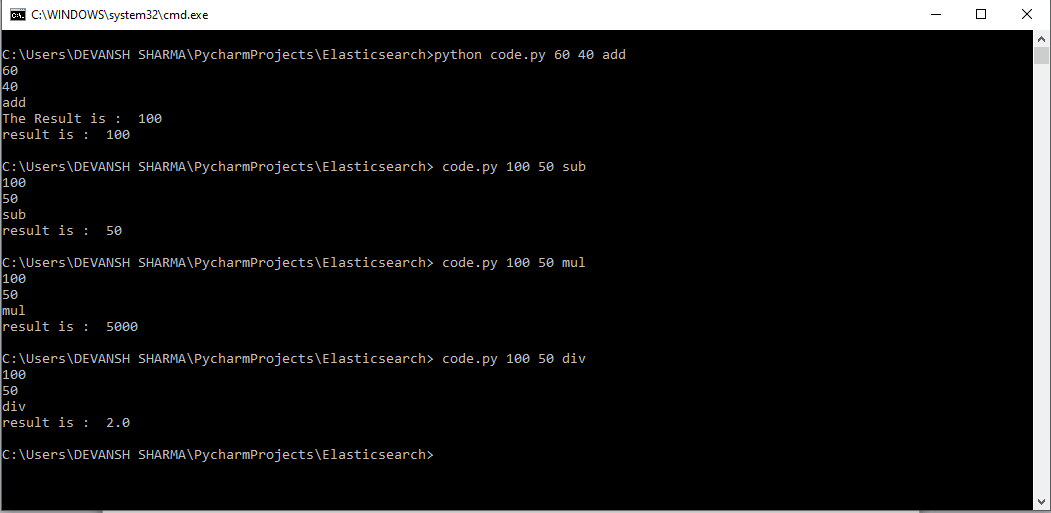 Types of Argument in Command Line InterfaceThere are two arguments that we can add to the command-line interface.
Let's understand the both arguments. Positional Argument - Positional arguments are the types of argument that we use in command to operate. We pass the argument to the command and perform some operations. Their position defines by their function. That's why they are called a positional argument. By default, the positional arguments are treated as String, however we can typecast in other data types. In the previous example, we have used positional arguments to perform the add operation between the two numbers. Let's understand the following code. Example - 1 Output: 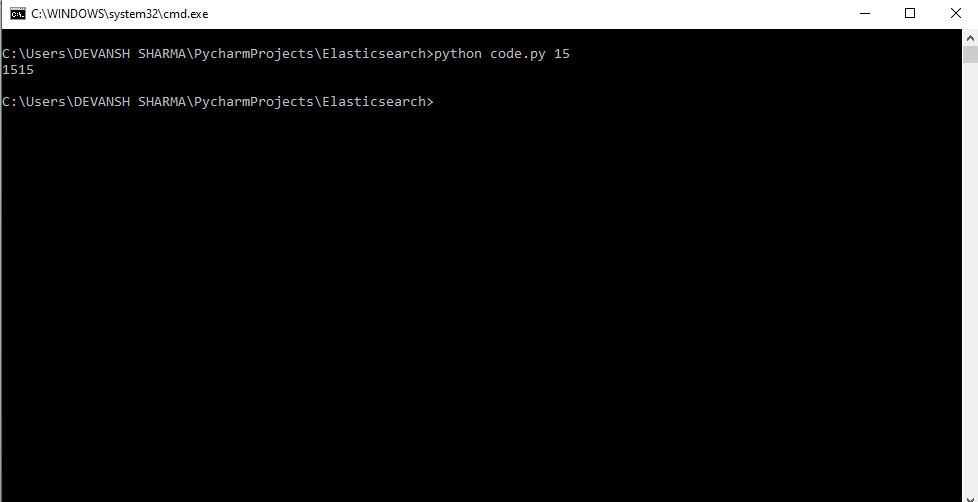 We have passed 15 and it returned 1515 because argparse treated as string. We can correct this using the type attribute. Example - Output: 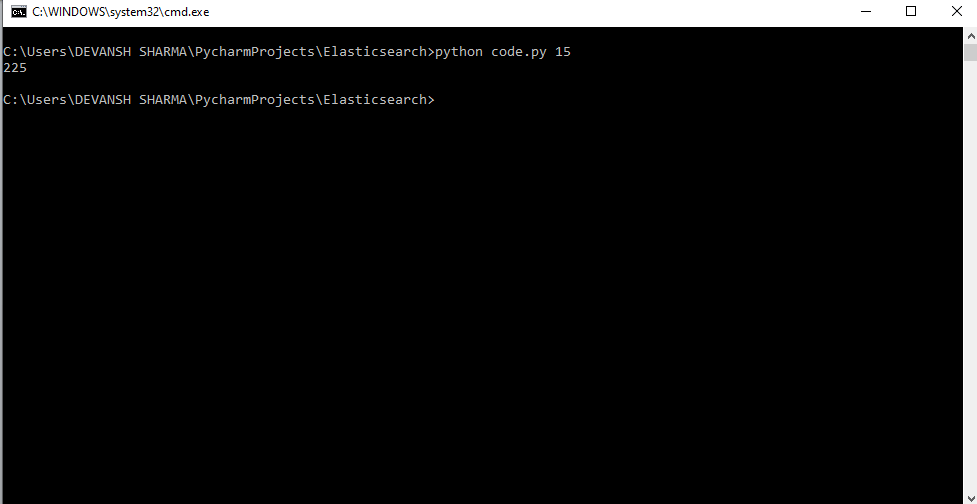 Now, we get the desired result. Optional Argument - Optional Argument are not mandatory. We will not get the error if not passed to the script. These types of arguments are started with the - single dash or "--" double dash prefix. We need to call the .add_parse() to pass the optional arguments. Let's understand the following example. Example - When we run the above code without passing any arguments, it will show the following output. Output: 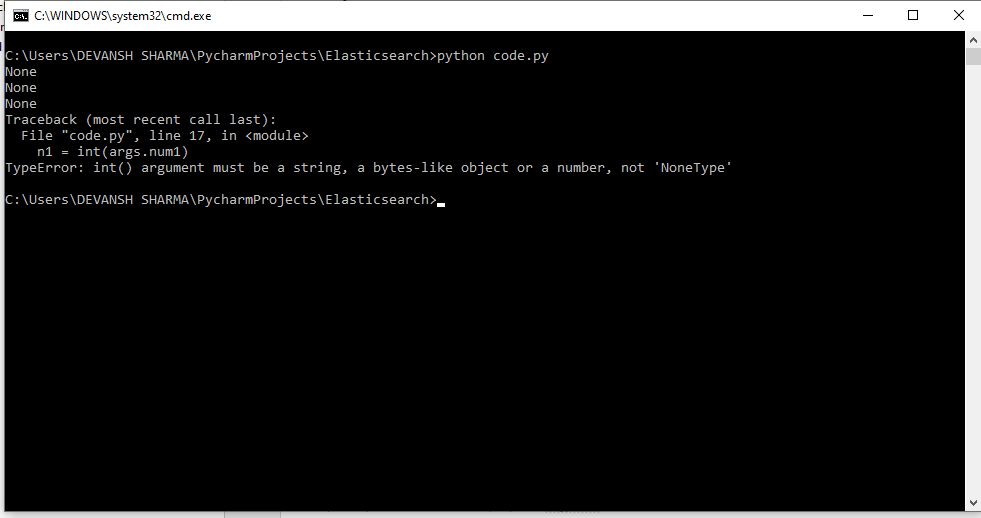 As we can see in the above code, we ran the script without passing any optional argument and instead of returning error it returns none. The help message and data types for optional parameters are same as in positional parameters. Python argparse Positional ArgumentSometimes, we need the arguments that are mandatory to be passed in the script on execution. Let's see an example it not passed. Example - When we run the above code with the different parameter, it will show the following argument. Output: 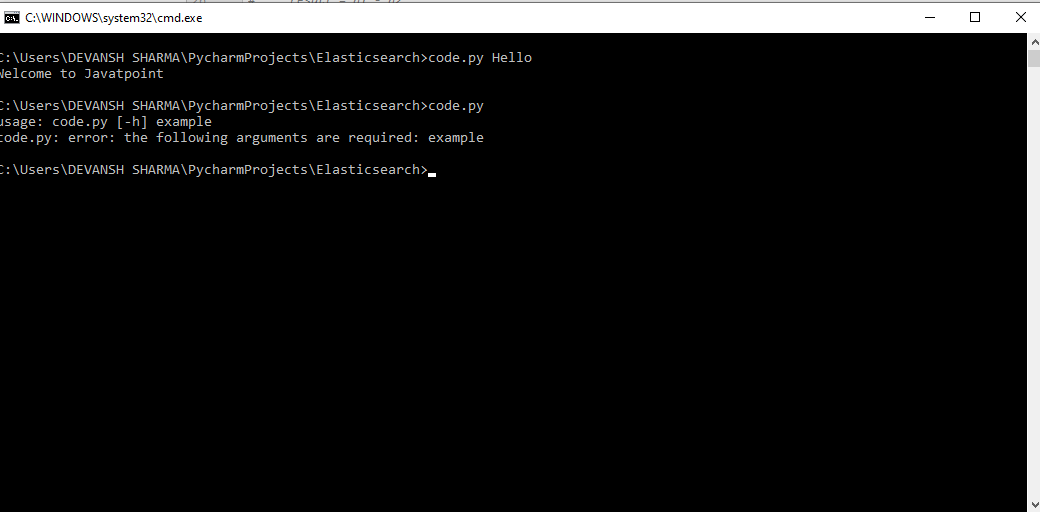 We can show the error if the argument is not passed in the command line terminal. Python argparse Positional Argument Default ValuesWe can provide the default value to a variable or argument using the argparse module. In the previous example, positional argument value is empty when not provided. Let's understand the following example. Example - Output: 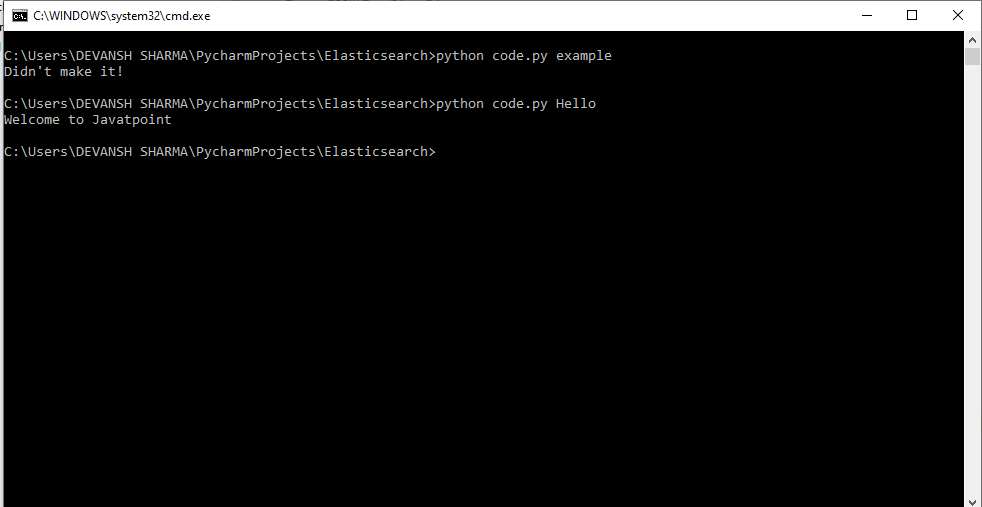 Using Short Name for Optional ArgumentPassing the many optional can make our Python script long. So we can assign the short name to the parameters as well. We can give the abbreviation name to parameters; it will help us to keep our Python script short. Let's understand the following example. Example - Output: C:\Users\DEVANSH SHARMA\PycharmProjects\Elasticsearch>python code.py -w Devansh Technical Writer. In the above code, we have assigned the short to both optional arguments. We can access it by using its short name. Combining Optional and Positional Arguments with argparseWe can combine both optional and position arguments using the argparse as follows. Let's understand the following example. Example - Output: C:\Users\DEVANSH SHARMA\PycharmProjects\Elasticsearch>python code.py Javatpoint -w Devansh You made it! Technical Writer. We have passed both types of argument to the command-line and get the above output. ConclusionSo far, we have discussed all-important concept of the argparse Python module. We have learned how we can create them and how we can use them through the command-line interface. We have also learned what the argparse module is and why it is important to write command-line scripts in Python. This module helps us create self-explanatory programs and provide users with a means of interacting with our application. Next TopicPython tqdm Module
|